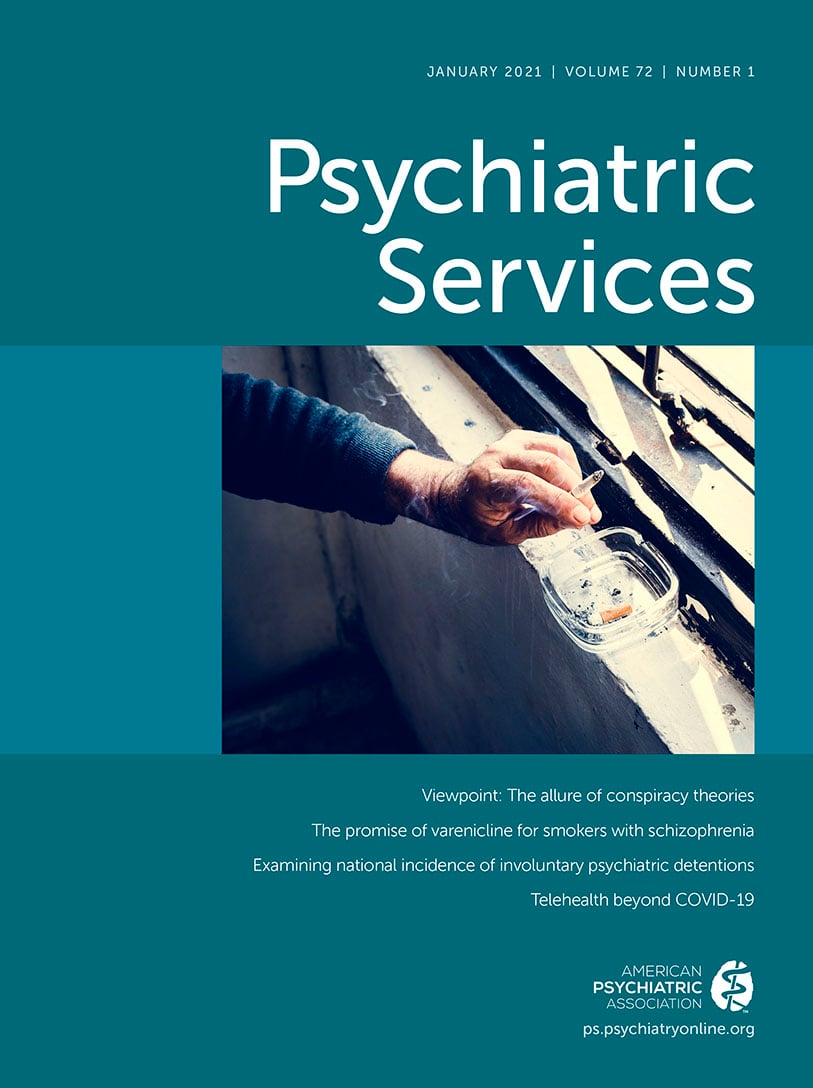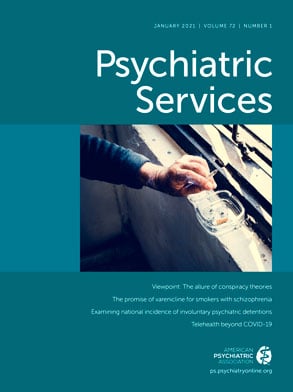The military conflicts in Iraq and Afghanistan have focused policy makers and clinicians within the U.S. Department of Veterans Affairs (VA) on efforts to engage veterans in the VA health care system. Although there has been some success in enrolling veterans in the VA health care system (
1), a significant percentage of veterans from the conflicts in Iraq and Afghanistan are reluctant to participate in mental health or substance abuse treatment, even when they may be experiencing distressing symptoms. Untreated mental health problems among veterans is a risk factor for veteran suicide, which remains at higher rates than corresponding civilian rates (
2).
Military veterans do not seek mental health care for various reasons: belief that treatment is not helpful or could worsen symptoms (
3,
4); stigma associated with seeking mental health services (
4); lack of knowledge about mental health conditions (
3); logistical issues, such as lack of transportation to distant VA facilities (
3); and inability to get time off from work (
4). Close loved ones are often aware of veterans’ struggles and, if provided with the skills to do so, can encourage the veteran to access care (
5). An effective method is needed to leverage the concerns of veterans’ loved ones to encourage and facilitate veterans’ efforts to seek mental health treatment.
Coaching Into Care (CIC) is a telephone-based service developed by VA to work with concerned family members and friends of veterans who are reluctant to initiate mental health care. The program helps these callers to be more effective in supporting veterans in the decision to seek care by using procedures similar to other telephone-based coaching approaches (
6) and similar to face-to-face interventions for relatives seeking help for a family member with substance abuse problems (
7). CIC was designed as a service for close friends and family members, rather than for veterans, to complement other VA efforts directed primarily to veterans (e.g., the “Choose VA” campaign). Involving family members and others close to veterans is consistent with many veterans’ preferences for their care (
8,
9).
Implementation and Evaluation of CIC
CIC was initiated as a nationally available service in June 2011. Staff are based in VA medical centers in Philadelphia; Durham, North Carolina; and Los Angeles. CIC operates as a core service funded by the Veterans Health Administration (VHA). One toll-free number is used to distribute incoming calls to staff at one of the three sites. Two levels of intervention are provided to callers: provision of basic information, education, and referrals by a call responder with a bachelor’s degree and a higher level of intervention, called coaching, typically provided by a licensed mental health provider. Coaching involves multiple telephone contacts with callers whose presenting situation involves more than a request for information or who report situations carrying high clinical risk. The goal of the coaching is to help callers to speak more effectively with their veteran loved one about initiating mental health treatment.
Callers are made aware of CIC through a multifaceted public awareness campaign, including traditional advertisements (e.g., television and radio) and a social media campaign. Additional outreach strategies include networking with VHA components, such as the Veterans Crisis Line, the Caregiver Support Line, the National Center for Posttraumatic Stress Disorder and other mental health Centers of Excellence, and with veterans-focused nonprofit organizations outside the VHA. Although all these strategies have led to referrals, an evaluation conducted for incoming calls from October 2014 to June 2015 indicated that the predominant sources of referrals (N=939, 45%) were the Veterans Crisis Line or other VA staff members, such as Vet Center coordinators. There was an increase from an initially low number of calls in 2011 to a stable, higher rate since 2014 (
Table 1). In the evaluation, we found that most of the callers to CIC were female (N=1,449, 75%), and most were spouses and/or intimate others (N=676, 35%), parents (N=413, 21%), or other family members and friends. Callers most commonly called about an Army veteran. Additionally, most of the callers were concerned about a veteran of the conflicts in Iraq and Afghanistan (N=896, 58% of those callers reporting the veteran’s service era), whereas 14% (N=218) of the callers cited concerns about a Vietnam War veteran. The other service eras were each represented at percentages under 10%. When asked about their experience with the service, most callers (N=1,844, 79%) reported that they received the information or help they were hoping for.
During their initial call to CIC, callers are assessed and triaged to the appropriate level of response. Callers are provided educational resources about mental health problems from websites such as the VHA’s National Center for PTSD and from mental health organizations external to VHA as a way to reduce the stigma of mental health and to normalize help-seeking (
10). When the caller reaches CIC on behalf of a veteran who needs and/or desires treatment, the caller is encouraged to use basic positive communication strategies to facilitate the discussion with the veteran. In most cases, the caller is provided clinical referrals within or outside VHA, depending on the preference of the caller and/or veteran. Routine follow-up calls with callers assess whether the caller judged the CIC intervention as successful, whether he or she reached the service to which he or she was referred, and whether the veteran subsequently attended a mental health appointment.
Callers are transitioned from the initial level of intervention to the higher-level coaching intervention to manage complex situations, with the particular goal of having the veteran initiate mental health care in cases where the veteran is reluctant to do so. The objectives of coaching are defined as empowering, motivating, educating, and increasing the caller’s listening and communication skills (
6) with the goal of enhancing the veteran’s intrinsic motivation for care. The intervention draws from self-determination theory (
11), which emphasizes humans’ underlying need for autonomy to maximize intrinsic motivation. Callers are encouraged to reduce their pressure on the veteran to seek care and to engage in more positive activities of interest to both. Callers are coached to listen for concerns expressed by the veteran, such as complaints about mood, anxiety, or the future (
11,
12). Furthermore, callers are encouraged to use an “autonomy-supportive” style of communication, which means offering to help the veteran but stating that it is understood that the offer is subject to the veteran welcoming this assistance (
11,
12). Coaching includes behavioral rehearsal to enhance the learning of these skills.
Because callers are at times resistant or ambivalent about changing their own behavior in order to have a more positive influence on the veteran, coaches use aspects of motivational interviewing, as developed by Miller and Rollnick (
13), to encourage consideration of these changes. A problem-solving approach (
14) is used to address logistical and access barriers associated with seeking care (
3,
4). Referrals for veterans’, callers’, and other family members’ treatment outside the VHA system are provided by using a national database of resources developed by CIC. Coaches tailor call frequency and length to the needs of the callers; a typical course of coaching lasts approximately 3 to 6 months.
In evaluating the program, we selected and reviewed the records of 165 callers who started working with a coach in October, November, or December 2014 or in January 2015 to determine the focus and outcomes of the coaching sessions through up to 6 months of coaching. Most callers (N=146, 89%) defined one or several goals related to encouraging initiation of mental health treatment for their veteran loved one, overcoming logistical barriers to the veteran’s treatment described by the caller, and/or wanting the veteran to improve his or her functioning. At the initial call to CIC, only 31% (N=51) of veterans were reported to be participating in mental health care of any kind. During the 6-month evaluation, we found that callers participated in a mean±SD of 3.49±2.77 coaching calls lasting 33.2±8.8 minutes. By the end of the 6-month review, 48% (N=79) of veterans were reported to have attended a mental health care visit, representing a statistically significant increase over the baseline rate (McNemar’s test, χ2=28.0, p<0.001).
CIC Challenges
Calls to CIC have been more complex than originally anticipated and have included helping veterans access additional mental health treatment services, addressing intimate partner violence, and addressing general concerns about the independent functioning of a veteran with or without a mental health condition. Thus, although the primary mission of CIC is to support veterans’ initiation of mental health treatment, the coaching must be flexible and tailored to each caller. We have coordinated with other VA telephone-based services, most notably the Veterans Crisis Line for immediate crises and the VA’s Caregiver Support Line for caregiving services, to address needs that are not best met by CIC.
We made several program decisions early in the development of the service to ensure veterans’ privacy and autonomy about treatment-seeking. We direct our efforts toward encouraging the caller to be more supportive of the veteran when voicing concerns, which may benefit the relationship, but entering mental health treatment remains the veteran’s choice. Importantly, the CIC program does not access veterans’ records; if there is evidence of high risk (e.g., suicidality), we engage the Veterans Crisis Line to mitigate the risks and to access veteran records if needed.

